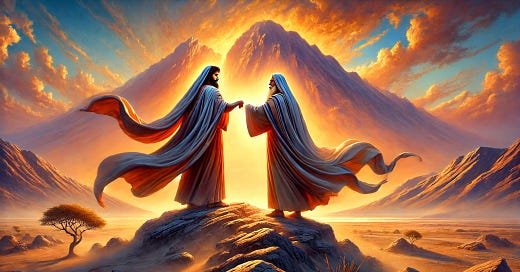An Unlikely Tale of Two Brothers
A thought on Parashas Shemos. Feel free to print and read over Shabbos.
Brothers are everything. No matter where life takes you or how strained the relationship may become, the bond of brotherhood remains unshakable. But let’s be real, brotherhood doesn’t just happen. It takes work. It’s a connection that demands effort, understanding, and sometimes a little humility. To be a brother is to live in a paradox: you’re the same yet totally different. It’s like being a twin—born of the same womb, yet destined to walk different paths.
(I should know, growing up with five brothers and five sisters was certainly an experience. You’d think that with so many different personalities, things would have been chaotic and, well, they often were. But now that we’re all married, it’s surprisingly easier to get along. Maybe we’ve mellowed out, or maybe we now have our spouses to keep us in line. Either way, it’s a lot more laughs than drama these days, and I wouldn’t trade it for anything.)
Throughout Sefer Bereishis, we meet brothers whose relationships are complicated, to say the least. Kayin and Hevel. Yitzchak and Yishmael. Yaakov and Esav. Yosef and his brothers. The pattern is striking: jealousy, betrayal, distrust. These fractured bonds set the stage for exile, landing Yaakov’s family in Egypt. It was the breakdown of brotherhood that ultimately led us into slavery.
By the time Shemos begins, the need for unity is glaring. The Egyptians enslaved us, tortured us, and sought to annihilate us. Yet before redemption could happen, before Moshe could lead the people out of Egypt, something foundational had to be rebuilt: brotherhood. This is where Moshe and Aharon’s relationship steps into the spotlight. It was more than a blood connection; it was about mutual respect, understanding, and a shared mission. Moshe and Aharon’s differences caused them to thrive. They brought out the best in each other, and through their unity, they brought out the best in the nation.
The Torah describes their meeting:
“And Hashem said to Aharon, ‘Go to meet Moshe in the wilderness.’ He went and met him at the mountain of Hashem, and he kissed him”.1
The Ramban explains that it was Aharon who kissed Moshe, not the other way around. In place of a mutual embrace, it was a moment of Aharon’s deep respect and love for Moshe. Moshe, in his humility, showed deference to his older brother despite his own elevated status. This act speaks volumes about their relationship—it’s not about power or hierarchy but about genuine respect.
The Netziv points out that the Torah doesn’t use the word “found” (“וימצאהו”) to describe their meeting but rather “met” (“ויפגשהו”). Why? Because their encounter wasn’t merely a physical meeting. It was two individuals, each immersed in their own spiritual realm, happening to cross paths in a moment of divine timing. The Netziv elaborates that Moshe was so absorbed in his mission, so elevated and detached, that he didn’t even notice Aharon approaching until their paths converged. Aharon, upon encountering Moshe in this state, was overwhelmed with love. He immediately understood how much Moshe had grown spiritually, recognizing the unique greatness that Moshe had attained. And when they met at the mountain of God, the magnitude of the moment was even greater. Aharon’s kiss was a gesture filled with awe and love for his brother, who had reached extraordinary heights.
The Midrash2 expands on this encounter by contrasting it with other sibling relationships in the Torah. While many brothers were plagued by jealousy and animosity—think Kayin and Hevel, Yaakov and Esav, Yosef and his brothers—Moshe and Aharon exemplified what true brotherhood could look like. When Moshe was chosen to lead Bnei Yisrael and Aharon was designated as the Kohen Gadol, neither harbored resentment. Instead, they celebrated each other’s roles. This is the kind of relationship described in Shir HaShirim: “If only you were like a brother to me”3. They were more than siblings; they were partners in redemption.
Moshe, initially hesitant to step into leadership, worried that his role might overshadow Aharon’s. Hashem reassured him, promising that Aharon would not only accept Moshe’s leadership but rejoice in it: “He will see you and be glad in his heart”4. This moment—a brother’s unbridled joy for the other’s success—is what makes their relationship so unique.
Moshe and Aharon’s relationship teaches us a crucial lesson: it’s okay to be different. In fact, it’s those differences that make relationships stronger. Moshe was the embodiment of truth and strict justice, as we see in Devarim5: “He executed the righteousness of Hashem.” Aharon, by contrast, represented kindness and peace, as described in Malachi6: “He walked with Me in peace and equity.” They weren’t competing; they were complementing each other. Together, they brought balance to Bnei Yisrael. Moshe upheld the integrity of the law, while Aharon fostered harmony and connection.
The Mei HaShiloach provides a profound exploration of the interplay of Moshe and Aharon’s middos and its significance for redemption. Moshe’s defining middos were emes (truth) and tzedek (righteousness), rooted in an unwavering commitment to justice and the absolute integrity of God’s law. Aharon, by contrast, embodied chesed (loving-kindness) and shalom (peace), cultivating patience and an enduring ability to accept challenges with faith and love. These middos often appear in tension: truth demands exactness and justice, while kindness seeks harmony and forgiveness.
The Mei HaShiloach quotes a Midrash7, which describes how these same middos participated in the creation of the world. God consulted chesed, which argued in favor of creation because the world would be filled with kindness. Emes objected, insisting the world should not be created because it would be full of lies. Tzedek supported creation because of the righteousness it would contain, while shalom opposed it due to the inevitable quarrels. Ultimately, God “threw truth to the earth” to enable creation.
This Midrash reflects the tension inherent in Moshe and Aharon’s middos. Moshe, like emes, was deeply troubled by the falsehood and injustice of Pharaoh’s rule and initially struggled with the idea of enduring such evil. Aharon, like chesed, had cultivated a mindset of patience and acceptance, trusting in God’s plan. Their meeting at the mountain symbolized a moment of profound reconciliation between these opposing forces. Their convergence represented a balance that Moshe had to learn—a fusion of truth tempered by patience and compassion.
When Moshe fled from Pharaoh, it marked a pivotal moment when emes was, in a sense, “cast down to the earth”.8 This was not a diminishment of truth but a transformation, allowing it to merge with chesed and become tzedek, a righteousness rooted in balance. Only once this equilibrium was achieved could Moshe and Aharon truly unite in their shared mission.
This is the meaning of the pasuk in Tehillim9: חסד־ואמת נפגשו צדק ושלום נשקו—“Kindness and truth have met; righteousness and peace have kissed.” The meeting of Moshe and Aharon reflects the harmonization of their middos—a merging of their spiritual attributes into a cohesive whole. Their relationship teaches that even opposing qualities can align for a higher purpose, creating the unity necessary for the redemption of Israel.
Moshe and Aharon’s relationship was a model for all of Bnei Yisrael. Brotherhood isn’t always easy, but it’s necessary. It’s the foundation of the redemptive process. Their unity reminds us that despite our differences, we can work together, complement each other, and build something greater than ourselves.
Today, the message of brotherhood is more relevant than ever. We’re all brothers and sisters, connected by a shared destiny. Whether it’s reuniting families torn apart by war or bridging divides within our communities, we can draw inspiration from Moshe and Aharon.
This theme of brotherhood and unity is echoed in Abie Rotenberg’s song “Dreams Come True,” where he reflects on the longing for familial connection:
“Let me tell a tale, I beg you all to listen,
I think you'll recognize that every word is true.
It's the story that I tell about my brother,
The brother that I loved but hardly knew.”
“How I dreamed that one day we could be together
Doing all the things that brothers do
But I feared that I would have to dream forever
For only dreamers still believe that dreams come true”
Let’s dream of a world where all brothers come home—from the tunnels of Gaza, from the melting pot of assimilation, from the distant lands of estrangement. Let’s take the lessons of Moshe and Aharon and apply them to our own lives. Because when we embrace true brotherhood, we pave the way for the geulah.
Previous posts on Parashas Shemos:
Facing fear: The Path to Redemption or Destruction
Shemos 4:27
Tanchuma, Shemos 27
Shir HaShirim 8:1
Shemos 4:14
Devarim 33:21
Malachi 2:6
Tanchuma, Shemot 28
as described in Daniel 8:12
Tehillim 85:11







Superb lesson!!